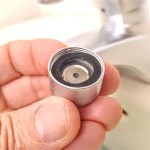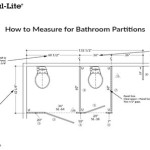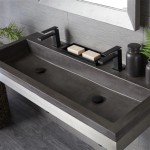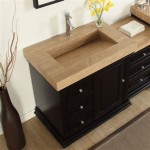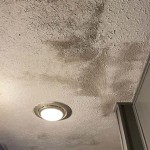How to Remove Stains in a Bathroom Sink: A Comprehensive Guide
Bathroom sinks, due to frequent use and exposure to various substances, are prone to staining. Soap scum, hard water deposits, rust, toothpaste residue, and even dyes from personal care products can contribute to unsightly marks on the sink's surface. Addressing these stains promptly and effectively is crucial to maintaining the hygiene and aesthetic appeal of the bathroom. This article provides a detailed guide on identifying common types of stains, selecting appropriate cleaning agents, and applying proven methods for stain removal, ensuring the longevity and cleanliness of the bathroom sink.
The effectiveness of stain removal depends heavily on the material of the sink. Common bathroom sink materials include vitreous china, porcelain, stainless steel, acrylic, and cast iron with enamel coating. Each material reacts differently to various cleaning agents, and using the wrong product can potentially damage the surface, leading to further aesthetic issues or structural compromise. Therefore, identifying the sink material before attempting any cleaning procedure is paramount. Consult the manufacturer's documentation or look for identifying markings on the sink itself. If the material remains uncertain, it is recommended to test the cleaning solution in an inconspicuous area before applying it to the entire stained surface.
Identifying Common Bathroom Sink Stains
Accurate identification of the type of stain present is the first step towards successful removal. The following are some of the most common stains found in bathroom sinks:
Soap Scum: This is a common white or grayish film that forms when soap reacts with hard water minerals. It is often found around the drain, faucet, and basin edges.
Hard Water Deposits: These appear as chalky white or yellowish deposits, particularly prominent around faucets and drains. They are caused by minerals like calcium and magnesium present in hard water.
Rust Stains: These orange or brown stains are typically caused by the oxidation of iron. They can occur near metal fixtures or from rusty objects left in the sink.
Toothpaste Residue: While seemingly minor, toothpaste can leave a cloudy film that hardens over time, creating a dull and difficult-to-remove stain.
Dye Stains: Hair dye, makeup, and other colored products can stain the sink, particularly if not cleaned up immediately. These stains can be highly resistant to general cleaning methods.
Mold and Mildew: In humid environments, mold and mildew can grow in bathroom sinks, manifesting as dark spots or a slimy film, often in areas with poor ventilation.
Selecting Appropriate Cleaning Agents and Tools
The selection of cleaning agents and tools is critical to effectively remove stains without causing damage to the sink. Avoid using abrasive cleaners on delicate materials like acrylic or enamel. Always start with the gentlest cleaning method possible and gradually increase the intensity if necessary.
Baking Soda: A mild abrasive cleaner that is effective for removing soap scum and toothpaste residue. It is safe for most sink materials.
Vinegar: An acidic cleaner that is effective for dissolving hard water deposits and soap scum. White vinegar is generally preferred due to its clarity.
Lemon Juice: Similar to vinegar, lemon juice is an acidic cleaner that can help remove hard water stains and provide a fresh scent.
Hydrogen Peroxide: A mild bleaching agent that can help remove dye stains and disinfect the sink. Use with caution on colored sinks, as it may cause fading.
Commercial Bathroom Cleaners: Numerous commercial bathroom cleaners are available, specifically formulated for removing soap scum, hard water deposits, and other common bathroom stains. Always read and follow the manufacturer's instructions carefully.
Specialized Rust Removers: For stubborn rust stains, specialized rust removers are available. These products often contain oxalic acid or other strong chemicals and should be used with caution, following all safety precautions.
Tools: Soft cloths, sponges, non-abrasive scouring pads, old toothbrushes, and spray bottles are essential tools for cleaning bathroom sinks. Avoid using steel wool or other highly abrasive materials, as they can scratch the sink surface.
Step-by-Step Stain Removal Techniques
The following techniques provide detailed instructions for removing common bathroom sink stains. Remember to always test cleaning solutions in an inconspicuous area before applying them to the entire stained surface.
Soap Scum Removal:
1. Wet the stained area with warm water.
2. Sprinkle baking soda onto the wet surface.
3. Gently scrub the area with a damp sponge or cloth in a circular motion.
4. Rinse thoroughly with warm water.
5. For stubborn soap scum, create a paste of baking soda and water. Apply the paste to the stained area and let it sit for 15-20 minutes before scrubbing and rinsing.
Hard Water Deposit Removal:
1. Soak a cloth or paper towel in white vinegar.
2. Place the vinegar-soaked cloth over the hard water deposits.
3. Let it sit for 30 minutes to an hour, or longer for heavy deposits.
4. Remove the cloth and scrub the area with a non-abrasive scouring pad or old toothbrush.
5. Rinse thoroughly with warm water.
6. For hard-to-reach areas, pour vinegar directly into the sink drain and let it sit for several hours before flushing with hot water.
Rust Stain Removal:
1. Apply a commercial rust remover according to the manufacturer's instructions. Wear gloves and eye protection when using these products.
2. Alternatively, make a paste of lemon juice and salt. Apply the paste to the rust stain and let it sit for 30 minutes.
3. Scrub the area with a non-abrasive scouring pad or old toothbrush.
4. Rinse thoroughly with warm water.
5. For severe rust stains, repeat the process or try a specialized rust removal product containing oxalic acid.
Toothpaste Residue Removal:
1. Wet the affected area with warm water.
2. Apply a small amount of dish soap to a damp sponge or cloth.
3. Gently scrub the toothpaste residue.
4. Rinse thoroughly with warm water.
5. For stubborn residue, use a baking soda and water paste and scrub gently.
Dye Stain Removal:
1. Apply hydrogen peroxide to the dye stain.
2. Let it sit for 15-30 minutes.
3. Gently scrub the area with a soft cloth or sponge.
4. Rinse thoroughly with warm water.
5. For stubborn dye stains, try using a commercial stain remover specifically designed for the type of dye causing the stain (e.g., hair dye remover).
6. If the sink is white, a bleach solution (diluted bleach with water) can be used with caution, but it is not recommended for colored sinks.
Mold and Mildew Removal:
1. Mix equal parts of bleach and water in a spray bottle.
2. Spray the solution onto the mold and mildew affected areas.
3. Let it sit for 10-15 minutes.
4. Scrub the area with a brush or sponge.
5. Rinse thoroughly with warm water.
6. Ensure proper ventilation to prevent future mold and mildew growth.
7. For a less harsh method, use a mixture of vinegar and water, following the same steps.
Regular maintenance is crucial for preventing stain buildup. Wiping down the sink after each use and periodically cleaning it with a mild detergent can significantly reduce the accumulation of stains and make it easier to maintain a clean and hygienic bathroom environment. Addressing spills and residues promptly also minimizes the risk of stubborn stains forming.
Furthermore, consider the quality of the water supply. If hard water is a persistent issue, installing a water softener can significantly reduce mineral deposits on the sink and other bathroom fixtures. Regular cleaning of faucet aerators and showerheads can also help prevent mineral buildup and ensure efficient water flow.

How To Remove Stains From A Porcelain Sink Isavea2z Com

No More Hard Water Stains How To Easily Clean Your Porcelain Sink In Minutes Vooki

How To Remove Rust Stains From A Porcelain Tub Or Sink Cabana State Of Mind

How To Get A Clean Porcelain Sink And Remove Rust Stains Too Mom 4 Real

How To Get A Clean Porcelain Sink And Remove Rust Stains Too Mom 4 Real

How Do I Remove This Embedded Stain From Bathroom Sink Hometalk

How To Remove Rust Stains From Toilets Tubs And Sinks

How To Get Rid Of Iron And Rust Stains Once For All Water Right

Removing Hard Water Stains From Bathroom Sinks

How To Remove Hard Water Stains In Your Bathroom
Related Posts

